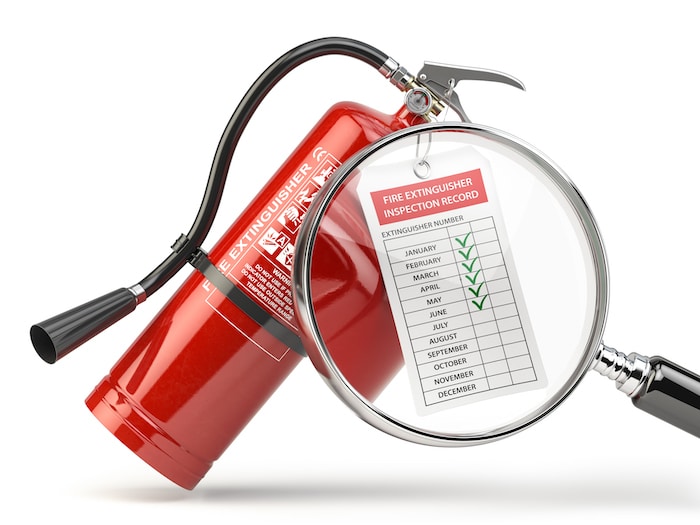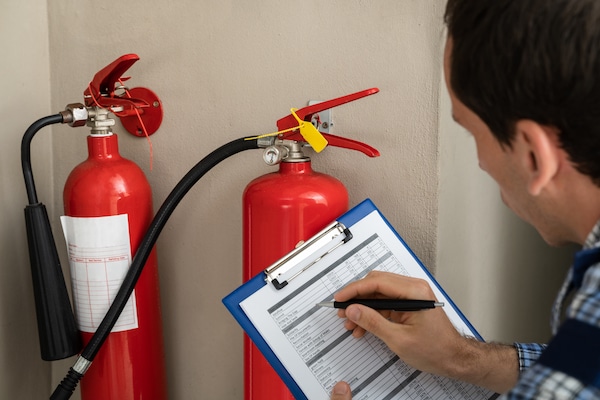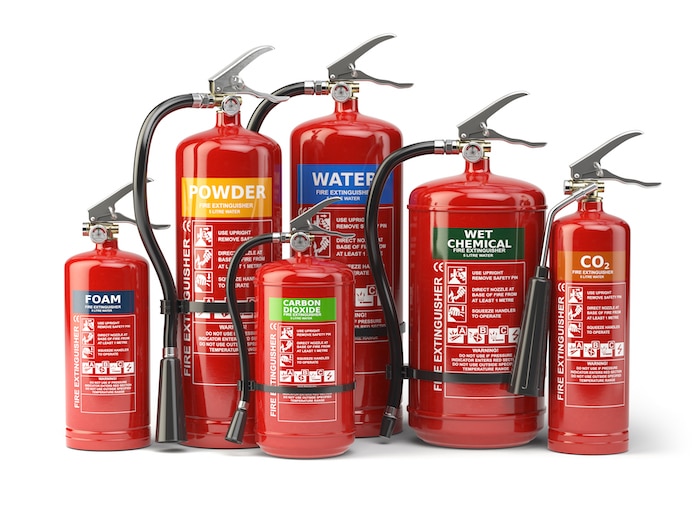How Often Should Fire Extinguishers Be Inspected? [in 2023]

In the average home or small business, the fire extinguisher is your first line of defense against stovetop mishaps and other potentially hazardous situations involving small fires. However, having an extinguisher around isn’t a buy-once-and-forget-about-it type of commitment. Keeping it in good working order requires several tiers of inspections, from monthly visual inspection to complete internal examination by a professional fire protection company. Step one is knowing how often should a fire extinguisher be inspected.
These types of inspections all occur at varying frequencies, but are all extremely important for the life safety of yourself and household in the case of an emergency. Keep reading for a full rundown of the different types of fire extinguisher inspections. These inspections are just a part of any Fire Extinguisher Training Program.

Why is Fire Extinguisher Inspection Important?
Household fire safety depends on having a fully functional portable extinguisher installed in a central, easy-to-reach location. If your extinguisher isn’t inspected regularly, you may not realize anything is wrong with it until you need it.
Remember, you can always reach out to your local fire protection company for advice on all things fire protection, including tips for visually inspecting your extinguisher.
The Different Types of Fire Extinguisher Inspections
There are three different types of inspections for portable fire extinguishers: visual inspections, hydrostatic testing, and maintenance inspections. Inspections will also vary by the type of fire extinguisher you are using.
Visual Fire Extinguisher Inspections
There are a number of steps involved in conducting a visual fire extinguisher inspection.
First, make sure the extinguisher is in its designated place, with appropriate signage indicating its position and use. The extinguisher should be easy to access and visible from multiple perspectives.
Next, check to see if the cylinder shows any signs of physical damage. This includes looking for rust, as well as checking the pull pin seal. Your extinguisher’s pull pin should have a tamper seal in place to keep the contents intact until you’re ready to use it.
The next step is checking to see that the pressure gauge is in the operable range. The needle on your pressure gauge should be in the green zone.
Finally, make sure your extinguisher is full. You can do this simply by picking it up, or by weighing it if you want a more exact reading.
There may be a few additional steps to your inspection depending on the type of extinguisher you have. For instance, a wheeled extinguisher should have its wheels, tires, and carriage given a thorough examination. If your portable fire extinguisher is non-rechargeable, use the push-to-test indicator to assess its functionality.
How Often Should I Inspect My Fire Extinguishers?
You should give your portable fire extinguisher a thorough inspection when it is first installed. After that, monthly visual inspections are recommended to make sure everything stays in good working order. A fire extinguisher that is located in a place where it may be exposed to rust or tampering should be inspected more frequently. Also, remember that fire extinguisher do expire so you will always want to perform a full maintenance on them when expiration occurs.
Visual Inspection Documentation
It’s important to keep a written or electronic record of your monthly inspections. You can also write the important information on a dated inspection tag attached to the extinguisher itself.
Each monthly visual inspection entry should include the month and year of the inspection. Make the writer leave their name in the record as well.

Hydrostatic Testing Procedures for Fire Extinguishers
Hydrostatic testing for portable fire extinguishers involves stripping away all the elements of your extinguisher and filling it with water to check for leaks and distortion. To ensure safety, this type of inspection needs to be conducted by a professional with the proper tools and certification.
How Frequently Should Extinguishers be Hydrostatically Tested?
The frequency of hydrostatic testing varies depending on the type of fire extinguisher you have. For instance, dry chemical extinguishers should be tested every twelve years, while carbon dioxide ones need hydrostatic testing every five years.
Documentation for Hydrostatic Tests
After completing the test and making sure your fire extinguisher is fully charged, the inspector will make a label including their name, the date of the inspection, and the pressure the test was performed at.
Maintenance Inspections for Fire Extinguishers
Fire extinguisher maintenance is a crucial part of ensuring your extinguishers are in good working order in the event of an emergency. Both external and internal maintenance inspections are required. To ensure safety, all maintenance should be conducted by a professional.
How Often Do Extinguishers Need Maintenance Inspections?
Fire extinguisher cylinders need an annual inspection to ensure they are in good working order. The annual inspection of fire extinguishers is usually external, though some extinguisher models need internal maintenance on a yearly basis as well.
Make sure to stay on top of any necessary maintenance for your fire extinguisher by scheduling all annual inspections well in advance. You don’t want to run into a scenario where you need to put out a small household fire and suddenly discover your extinguisher is broken or not functioning properly. Besides, not every professional fire protection company operates 24/7; for instance, your local company may closed Sunday and therefore unable to assist you with same-day repairs.
Maintenance Inspection Documentation
After conducting your fire extinguisher inspection and maintenance, the professional who inspected your fire extinguishers should record their name and the name of their agency, as well as the year and date the fire extinguisher inspection took place.
The Bottom Line
Fire safety should always be taken seriously, and an important part of this safety in the home is keeping up with all fire extinguisher maintenance and inspections. Update your records after each inspection so you know when to schedule the next one, and reach out to your local fire safety experts with any questions. Knowing how often fire extinguishers should be inspected is step one of your overall fire safety program. Along with training, inspections are key to keeping your facility safe from tragedy or loss of life.